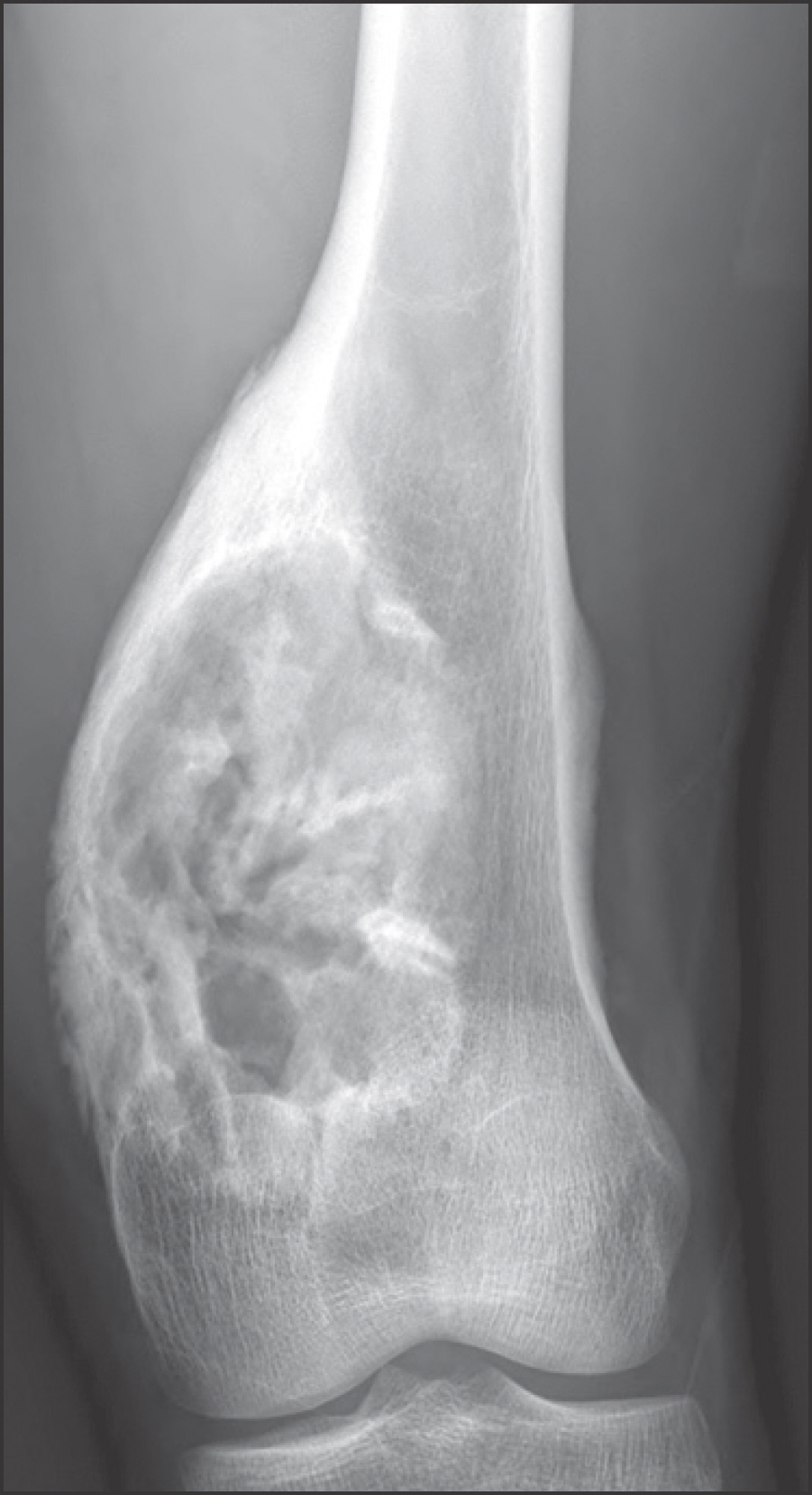J Korean Bone Joint Tumor Soc.
2014 Dec;20(2):47-53. 10.5292/jkbjts.2014.20.2.47.
Diagnosis, Treatment and Prognosis of Low Grade Central Osteosarcoma
- Affiliations
-
- 1Department of Orthopedic Surgery, Korea Cancer Center Hospital, Seoul, Korea. dgjeon@kcch.re.kr
- 2Department of Pathology, Korea Cancer Center Hospital, Seoul, Korea.
- KMID: 1799892
- DOI: http://doi.org/10.5292/jkbjts.2014.20.2.47
Abstract
- PURPOSE
We analyzed the diagnosis and the treatment outcomes of patients with central low grade osteosarcoma.
MATERIALS AND METHODS
We retrospectively reviewed 16 patients with central low grade osteosarcoma were treated at out institution between 1994 and 2011.
RESULTS
There were 4 men and 12 women with mean age of 26 years. Eleven patients were correctly diagnosed but 5 patients were misdiagnosed as osteoid osteoma, non ossifying fibroma, aneurysmal bone cyst, desmoplastic fibroma. 15 patients finally received wide margin en bloc excision and one of them treated under neoadjuvant chemotherapy. Final survival status was continuous disease free in 14 and 1 patient died of renal cell cancer. Remaining 1 with multifocal lesions is alive with disease for 7 years only treated radiation therapy on residual tumors. Nine (56%) of 16 tumors showed extra-osseous extension of tumor (56%) and 1 of them showed extra-compartmental tumors.
CONCLUSION
The diagnosis of central low grade osteosarcoma is challenging, however, considering of the clinical suspicion, the typical findings of radiologic and pathologic features, proper diagnosis is needed. This tumor should be treated with wide excision, even after an intralesional excision, to avoid local recurrence or transformation to higher histologic grade.
Keyword
MeSH Terms
Figure
Reference
-
References
1. Schwab JH, Antonescu CR, Athanasian EA, Boland PJ, Healey JH, Morris CD. A comparison of intramedullary and juxtacortical low-grade osteogenic sarcoma. Clin Orthop Relat Res. 2008; 466:1318–22.
Article2. Kurt AM, Unni KK, McLeod RA, Pritchard DJ. Low-grade intraosseous osteosarcoma. Cancer. 1990; 65:1418–28.
Article3. Choong PF, Pritchard DJ, Rock MG, Sim FH, McLeod RA, Unni KK. Low grade central osteogenic sarcoma. A longterm followup of 20 patients. Clin Orthop Relat Res. 1996; 322:198–206.
Article4. Franceschina MJ, Hankin RC, Irwin RB. Low-grade central osteosarcoma resembling fibrous dysplasia. A report of two cases. Am J Orthop (Belle Mead NJ). 1997; 26:432–40.5. Kenan S, Ginat DT, Steiner GC. Dedifferentiated high-grade osteosarcoma originating from low-grade central osteosarcoma of the fibula. Skeletal Radiol. 2007; 36:347–51.
Article6. Muramatsu K, Hashimoto T, Seto S, Gondo T, Ihara K, Taguchi T. Low-grade central osteosarcoma mimicking fibrous dysplasia: a report of two cases. Arch Orthop Trauma Surg. 2008; 128:11–5.
Article7. Andresen KJ, Sundaram M, Unni KK, Sim FH. Imaging features of low-grade central osteosarcoma of the long bones and pelvis. Skeletal Radiol. 2004; 33:373–9.
Article8. Bertoni F, Bacchini P, Fabbri N, et al. Osteosarcoma. Low-grade intraosseous-type osteosarcoma, histologically resembling parosteal osteosarcoma, fibrous dysplasia, and desmoplastic fibroma. Cancer. 1993; 71:338–45.
Article9. Kumar A, Varshney MK, Khan SA, Rastogi S, Safaya R. Low grade central osteosarcoma–a diagnostic dilemma. Joint Bone Spine. 2008; 75:613–5.10. Hayashi K, Tsuchiya H, Yamamoto N, et al. Diagnosis and treatment of low-grade osteosarcoma: experience with nine cases. Int J Clin Oncol. 2014; 19:731–8.
Article11. Malhas AM, Sumathi VP, James SL, et al. Low-grade central osteosarcoma: a difficult condition to diagnose. Sarcoma. 2012; 2012:764796.
Article12. Yoshida A, Ushiku T, Motoi T, et al. Immunohistochemical analysis of MDM2 and CDK4 distinguishes low-grade osteosarcoma from benign mimics. Mod Pathol. 2010; 23:1279–88.
Article13. Antonescu CR, Huvos AG. Low-grade osteogenic sarcoma arising in medullary and surface osseous locations. Am J Clin Pathol. 2000; 114(Suppl):S90–103.
Article14. Gisselsson D, Pålsson E, Höglund M, et al. Differentially amplified chromosome 12 sequences in low- and high-grade osteosarcoma. Genes Chromosomes Cancer. 2002; 33:133–40.
Article15. Tarkkanen M, Böhling T, Gamberi G, et al. Comparative genomic hybridization of low-grade central osteosarcoma. Mod Pathol. 1998; 11:421–6.16. Song WS, Jeon DG, Kong CB, Cho WH, Lee SY. Outcome of re-excision for intralesionally treated parosteal osteosarcoma. J Surg Oncol. 2011; 103:264–8.
Article
- Full Text Links
- Actions
-
Cited
- CITED
-
- Close
- Share
- Similar articles
-
- Differential Expression of CXCR4 in Conventional High-grade and Low-grade Central Osteosarcoma and Its Prognostic Implications
- Low-grade Osteosarcoma of the Spine: A Case Report
- A Case of Osteosarcoma in Maxilla
- Expression of Carbonic Anhydrase IX Correlates with Histologic Grade and Metastasis in Osteosarcoma
- Metachronous osteosarcoma





